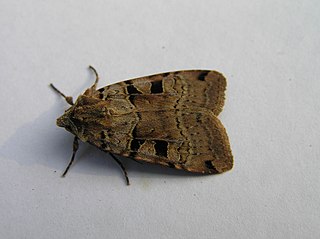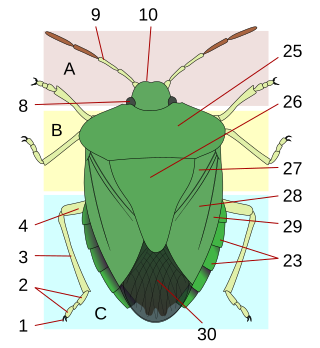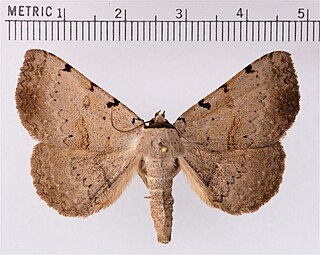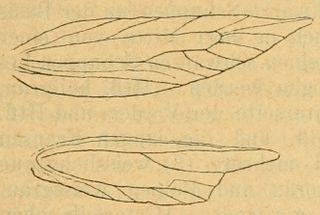
An elytron is a modified, hardened forewing of beetles (Coleoptera), though a few of the true bugs (Hemiptera) such as the family Schizopteridae are extremely similar; in true bugs, the forewings are called hemelytra, and in most species only the basal half is thickened while the apex is membranous, but when they are entirely thickened the condition is referred to as "coleopteroid". An elytron is sometimes also referred to as a shard.

Laothoe populi, the poplar hawk-moth, is a moth of the family Sphingidae. The species was first described by Carl Linnaeus in his 1758 10th edition of Systema Naturae. It is found throughout the Palearctic region and the Near East and is one of the most common members of the family in the region. It is distinctive due to its habit of resting with its hindwings held further forward than the forewings.

The brimstone moth is a moth of the family Geometridae. The species was first described by Carl Linnaeus in his 1758 10th edition of Systema Naturae. It should not be confused with the brimstone butterfly Gonepteryx rhamni.

The double square-spot is a moth of the family Noctuidae. It is distributed through most of Europe except Portugal, the Mediterranean islands and northernmost Fennoscandia. In the East, the species ranges East across the Palearctic to Siberia and in the South-East to the Black Sea and in Iran. It rises to a height of about 2,000 metres (6,600 ft) in the Alps.

Grass skippers or banded skippers are butterflies of the subfamily Hesperiinae, part of the skipper family, Hesperiidae. The subfamily was established by Pierre André Latreille in 1809.

The sycamore is a moth of the family Noctuidae. The species was first described by Carl Linnaeus in his 1758 10th edition of Systema Naturae. It is distributed through most of Europe, from central England south to Morocco. To the east it is found from the Near East and Middle East to western Asia.

The miller is a moth of the family Noctuidae. It is found throughout Europe apart from the far south-east. The range extends from the South of Spain, Central Italy and Bulgaria to Scotland and Central Scandinavia, crossing the Arctic circle in Finland and Norway. Outside Europe it is only known in North Africa. In the Eastern Palearctic and the Nearctic realm it is replaced by Acronicta vulpina, formerly known as Acronicta leporina subspecies vulpina.

Papilio buddha, the Malabar banded peacock, is a species of swallowtail butterfly found in the Western Ghats of India. The Government of Kerala declared it as the official Kerala state butterfly.

The scutellum is the posterior portion of either the mesonotum or the metanotum of an insect thorax; however, it is used almost exclusively in the former context, as the metanotum is rather reduced in most insect groups. In the Hemiptera, and some Coleoptera, the scutellum is a small triangular plate behind the pronotum and between the forewing bases. In Diptera and Hymenoptera the scutellum is nearly always distinct, but much smaller than the mesoscutum.

Junonia hierta, the yellow pansy, is a species of nymphalid butterfly found in the Palaeotropics. It is usually seen in open scrub and grassland habitats.

Hypolimnas misippus, the Danaid eggfly, mimic, or diadem, is a widespread species of nymphalid butterfly. It is well known for polymorphism and mimicry. Males are blackish with distinctive white spots that are fringed in blue. Females are in multiple forms that include male-like forms while others closely resemble the toxic butterflies Danaus chrysippus and Danaus plexippus.

The dryandra moth is a species of moth that is considered to be the sole member of the family Carthaeidae. Its closest relatives are the Saturniidae and it bears a resemblance to many species of that family, bearing prominent eyespots on all wings. The common name is derived from the Dryandra shrubs of the genus Banksia, on which the larva of this species feed, and is hence restricted to the south-west of Western Australia where these shrubs grow. Other Grevillea shrubs may also be used as host plants.

The Blastobasidae are a family of moths in the superfamily Gelechioidea. Its species can be found almost anywhere in the world, though in some places they are not native but introduced by humans. In some arrangements, these moths are included in the case-bearer family (Coleophoridae) as subfamily Blastobasinae. The Symmocidae are sometimes included in the Blastobasidae as subfamily or tribe.

The Catocalini are a tribe of moths in the family Erebidae. Adults of many species in the tribe are called underwing moths due to their vividly colored hindwings that are often covered by contrastingly dark, drab forewings.

Lyonetiidae is a family of moths with some 200 described species. These are small, slender moths, the wingspan rarely exceeding 1 cm. The very narrow forewings, held folded backwards covering the hindwings and abdomen, often have pointed apices noticeably up- or down-turned. The larvae are leaf miners.

Coloptilia is a genus of moths in the family Gelechiidae described by Thomas Bainbrigge Fletcher in 1940.

Lasiommata maera, the large wall brown, is a butterfly in the family Nymphalidae.

Phragmatobia fuliginosa, the ruby tiger, is a moth of the family Erebidae.

The Erebidae are a family of moths in the superfamily Noctuoidea. The family is among the largest families of moths by species count and contains a wide variety of well-known macromoth groups. The family includes the underwings (Catocala); litter moths (Herminiinae); tiger, lichen, and wasp moths (Arctiinae); tussock moths (Lymantriinae), including the arctic woolly bear moth ; piercing moths ; micronoctuoid moths (Micronoctuini); snout moths (Hypeninae); and zales, though many of these common names can also refer to moths outside the Erebidae. Some of the erebid moths are called owlets.
Apatetrinae is a subfamily of moths in the family Gelechiidae. The subfamily was described by Edward Meyrick in 1947.



















